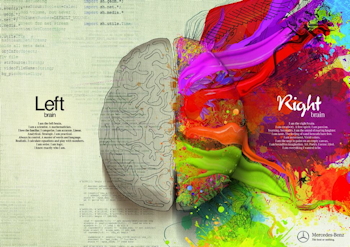Creative Alchemy – idea to realization
Does the mind look like it is pulling things out of thin air when something new is created? Does it seem like magic? Perhaps and perhaps not.
What is this write-up is about…
What goes into creation process… the design process…
The different processes or the lack of one,
The spark, the inspirations, the chaos that give life and form to an abstract idea.
Get an insight into creative process of architectural design and its adaptation to UX design.
All of the creative folks will be in 200% agreement with Calvin
Learnings from architecture education
- Design isn’t about formulas
- Order is rare in life
- Chaos and uncertainty become your pals and you start believing in serendipity and flashes of inspiration and the like.
- Concentration is inversely proportional to time – thanks to last minute panic!
- Your first solution is 90% of the time not the best.
- Let go of your favorite idea as it may not be the best solution
- Course correct every now and then, and, come up with alternatives.
- Never be afraid to go off the track – dream up something that looks implausible and see how you can realize it.
- Experiment, take risks – you may fall, and that’s when you get to see the ground up close and personal and see the sky from the worm’s eye view. And, you may also sink so deep that you’ll see the magma in the core. And who knows you might be caught in an erupting volcano and get a free ride and land on higher ground!
More learning…
- Process is just a guideline, yet it lays the foundation for design thinking so that you don’t derail and make art based on your whims and fancies.
- Design is not always a medium for personal expression. You can add your signature to it but it is always a design solution for someone else’s needs and problems.
- Design is a union of the left(logic and problem solving) and the right brain (artsy). It is where Art and Science come together to find an answer to a problem.

- Change the perspective – go around the table and look at the sheet from a different angle and you’ll see solutions emerge
- Iterate – more butter sheets and markers and pentels , the better

- Be passionate and observant of the world around
- Question things
Illusions and the diminishing line between the real and the ‘not so real’
- Sometimes the wait for inspiration can be excruciatingly painful.
- Dreams will become important in life. So will music that seem to solve your design problems. You would have solved a problem in your dreams but when you wake up, the sheet would still be empty! You’d wish you’re hand was awake translating those ideas!
- You may start discussing design with your hostel cat
- It is darkest before dawn and you’ll see it – thanks to the countless night outs
- You may even cry when you lose your favorite pentel. It is a ‘religious’ fanatical attachment like you’ve lost your limb or something – it becomes an extension of you.
From chaos to order or to more chaos, and, back to a new order
The design process can seem and many a times is chaotic and random.
But there is a method to all the madness.
Here are some of the phases from Architecture education.
- Requirements gathering
- Research and case studies
- Concept sketches
- Schematic design
- Detailed design
- Presentation
I look at each of them as dots which get connected in various ways to solve different problems. This process cannot always be linear, and, there are a lot of black holes, unexpected chaos, expected chaos and turbulence at various stages.
So what takes you to a great design?
While process guides you, your solutions will not always be great just because you followed a process.
Design has touch points across all forms of art and life in general. The earth, the universe is your inspiration and your book.
- See and not just look
- Be a sponge and soak in the things you see.
- Read about different things -art, prose, philosophy, photography, music , people, animals, plants – the more the dots, the more richer the connections.
- Stay curious and don’t stop questioning
- Be empathetic
- Travel, taste and smell the world
- Keep the wonder alive
The more and more you observe, patterns will start emerging. And all the random dots will connect in ways you’ve never imagined and let you create things you had never imagined.
Back to the architectural design process
Phase 1: Requirements
- This is a very important step that can’t be skipped.
- Ask the right questions , ask stupid questions, fundamental questions and whatever it takes for you to understand the problem you’re trying to solve.
- Never shy away from asking.
- You can never find a solution for something you’re not clear about.
- Understand what you will be designing and for whom and where (user, context).
- Understand the constraints and the budget. Learn about the site and it’s context – the buildings around it, the landscape and the climate.
Phase 2: Research and case study
- Go research – study existing buildings, talk to people who inhabit the space.
- Read a lot – about the subject and things unrelated to the subject.
- Find inspiration from varied sources. You never know what might spark that inspiration.
Phase 3: Concept sketches
- This is the phase for divergent thinking
- Start sketching – explore – let your imagination run wild, don’t start judging your designs. Just keep sketching.
- When you hit a brick wall – take a break, get away from the sketches – watch the raindrops fall, let the brain do the work
Phase 4: Schematic drawings
- Convergent thinking – this stage and the next stages is where the idea converges into a whole
- This is when you start detailing out one of the concepts. Detailing it out is more of a stress test of the concept sketches.
- You may change course and go back to another concept or come up with a new concept. That’s fine. Once you pick a path, continue detailing it. This is an important phase where you see the designs come closer to realization.
Phase 5: Design Detailing
- By this time you’ve picked the path and you continue to detail out the design.
- You shift from macro vision to micro vision.
- Devil is in the details and you will have to work on all the minute details that makes the space a livable one.
Phase 6: Presentation and design crit
- Presentation is key, as this is the face of your design.
- You learn to sell your design in this phase.
- You learn how to present your design in the most unique and impressive way.
- You learn to speak clearly and get buy in from people in the room
- The design crits teach you to defend your idea – you learn to stand up for your idea and defend it despite the criticism and opposition.
- But remember, you should also consider the other person’s perspective. It is the different perspectives that make a design better. You learn this in the profession where different people bring in different points of view.
Similarities in the UX design process
Designing an interface and the user experience for a software application has a similar set of phases in the process.
Requirements
Research
Concept sketches
Design validation
Design specification
Monitoring
Conclusion
A stronghold in any field of design and the understanding of the process definitely acts as a guideline to design the user experience of software applications. But process itself will not help you create great designs and create transformational innovations. You need to explore, experiment, look, see, empathize and absorb the world around you. The more and more you observe, patterns will start emerging, and, all the random dots will connect in ways you’ve never imagined and let you create things you had never imagined.
And finally…
From none other than Steve Jobs…
Images courtesy: free images on Google image search







